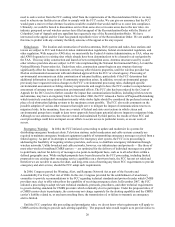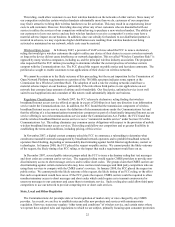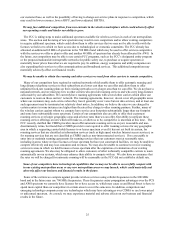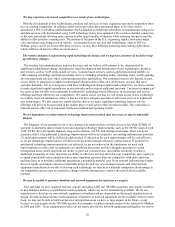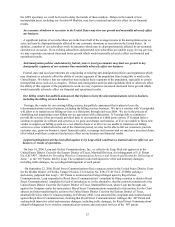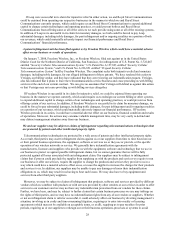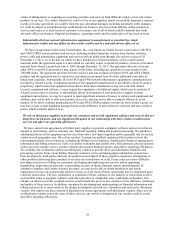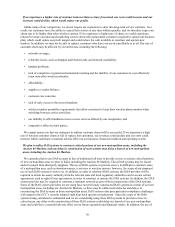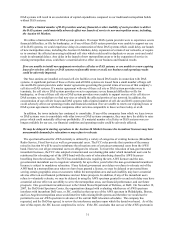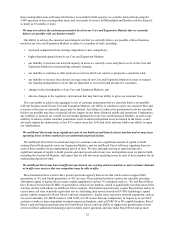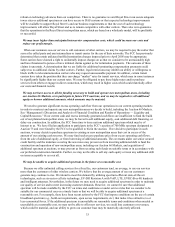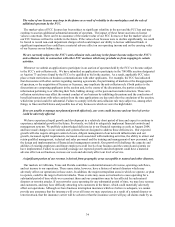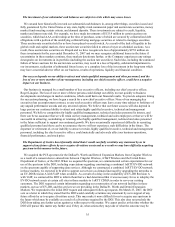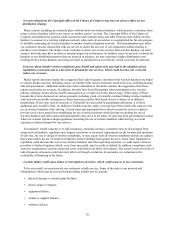Metro PCS 2007 Annual Report Download - page 41
Download and view the complete annual report
Please find page 41 of the 2007 Metro PCS annual report below. You can navigate through the pages in the report by either clicking on the pages listed below, or by using the keyword search tool below to find specific information within the annual report.30
If we experience a higher rate of customer turnover than we have forecasted, our costs could increase and our
revenues could decline, which would reduce our profits.
Unlike many of our competitors, we do not require our customers to enter into long-term service contracts. As a
result, our customers have the ability to cancel their service at any time without penalty, and we therefore expect our
churn rate to be higher than other wireless carriers. If we experience a higher rate of churn, we could experience
reduced revenues and increased marketing costs to attract the replacement customers required to sustain our business
plan, which could reduce our profit margin and could reduce the cash available to construct and operate new
markets. In addition, we may not be able to replace customers who leave our service profitably or at all. Our rate of
customer churn may be affected by several factors, including the following:
• network coverage;
• reliability issues, such as dropped and blocked calls and network availability;
• handset problems;
• lack of competitive regional and nationwide roaming and the inability of our customers to cost-effectively
roam onto other wireless networks;
• affordability;
• supplier or vendor failures;
• customer care concerns;
• lack of early access to the newest handsets;
• wireless number portability requirements that allow customers to keep their wireless phone number when
switching between service providers;
• our inability to offer bundled services or new services offered by our competitors; and
• competitive offers by third parties.
We cannot assure you that our strategies to address customer churn will be successful. If we experience a high
rate of wireless customer churn or fail to replace lost customers, our revenues could decline and our costs could
increase which could have a material adverse effect on our business, financial condition and operating results.
We plan to utilize DAS systems to construct critical portions of our new metropolitan areas, including the
Auction 66 Markets, and any delay in construction of such systems may delay a launch of new metropolitan
areas, including the Auction 66 Markets.
We currently plan to use DAS systems in lieu of traditional cell sites to provide service to certain critical portions
of new metropolitan areas we plan to build, including the Auction 66 Markets. These DAS systems may be leased
and/or licensed from third party suppliers. The use of DAS systems to provide service in difficult to construct areas
of a metropolitan area, such as downtown areas, is not new to wireless carriers; however, the scope of our proposed
use of such DAS systems is new to us. In addition, in order to construct DAS systems, the DAS provider will be
required to obtain necessary authority from the relevant state and local regulatory authorities and to secure certain
agreements, such as right of way agreements, in order to construct or operate the DAS systems. In addition, the DAS
system provider may be required to construct a transport network as part of their construction of the DAS systems.
Some of the DAS system providers we are using have not previously constructed DAS systems in certain of our new
metropolitan areas, including our Auction 66 Markets, so there may be unforeseen obstacles and delays in
constructing the DAS systems in those metropolitan areas. DAS systems also pose particular compliance challenges
with regard to the FCC’ s recently adopted eight hour back up power requirement. Since the scope of the DAS
systems being considered is substantial and we are considering using these DAS systems to provide service in
critical areas, any delay in the construction of these DAS systems could delay our launch of our new metropolitan
areas and could have a material adverse effect on our future operations and financial results. In addition, the use of


